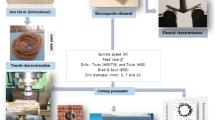Abstract
The delamination in drilling of medium density fibreboard (MDF) materials significantly reduces the performance and aesthetical aspects of the final product. Therefore, understanding the delamination tendency and the parameters affecting the same is essential for controlling the delamination factor. The present study investigates the relationships and parametric interaction between two controllable variables, namely, feed rate and cutting speed on the delamination factor at entry and exit of the holes in drilling of MDF. The experiments have been planned as per Taguchi’s L 18 mixed orthogonal array and the responses, namely, delamination factor at entry and exit of the holes have been modeled using response surface methodology (RSM). Two types of MDF panels, SUPERPAN DÉCOR (melamine coating layer) and LAMIPAN PB (wood coating layer) were tested using cemented carbide (K20) drills. The analysis of variance (ANOVA) was performed to verify the adequacy of the mathematical models. The response surface analysis has been carried out to study the main and the interaction effects of the machining parameters.
Similar content being viewed by others
References
Irle M, Loxton C (1996) Manufacture and use of panel products in the UK. J Inst Wood Sci 14:21–26
Chapman KM (1998) Composite panels in Australia and New Zealand: a focus on MDF. Proc 32nd Int Particleboard/Composite materials Symposium, Pullman, WA, USA, pp 75–82
Sun X, Hammett AL (1999) Chinese furniture industry: Its development and wood use. For Prod J 49:31–35
Sun X, Hammett AL, West CD (1999) Hardwood use in China’s furniture industry. For Prod J 49:51–59
Fuller B (2001) Opportunities versus expectations: world market prospects for OSB and MDF. Proc 35th Int Particleboard/Composite materials Symposium. Pullman, WA, USA, pp 75–83
Wu O, Vlosky RP (2001) Panel products: a perspective from furniture and cabinet manufactures in the southern United States. For Prod J 50:45–58
Olah D, Smith R, Hansen B (2003) Wood materials use in the U.S. cabinet industry 1999 to 2001. For Prod J 53:25–31
Penman D, Olsson OJ, Bowman CC (1993) Automatic inspection of reconstituted wood panels for surface defects. Proc SPIE 1823:284–292
Bhattacharyya D, Allen MN, Mander SJ (1993) Cryogenic machining of Kevlar composites. Mater Manuf Process 8:631–652
Blackman T (2000) Who needs a bunch of trees to make MDF? Not this Mill. Wood Tech 127:20–23
Dippon J, Ren H, Amara FB, Altintas Y (2000) Orthogonal cutting mechanics of medium density fibreboards. For Prod J 50:25–30
Engin S, Altintas Y, Amara FB (2000) Mechanics of routing medium density fibreboard. For Prod J 50:65–69
Zhao H, Ehmann KF (2002) Development and performance analysis of new spade bit designs. Int J Mach Tools Manuf 42:1403–1414
Lin RJ, Van Houts J, Bhattacharyya D (2006) Machinability investigation of medium-density fibreboard. Holzforschung 60:71–77
McKenzie WM, Ko P, Cvitkovic R, Ringler M (2001) Towards a model predicting cutting forces and surface quality in routing layered boards. Wood Sci Technol 35:563–569
Aguilera A, Meausoone PJ, Martin P (2000) Wood material influence in routing operations: the MDF case. Holz als Roh Werkstoff 58:278–283
Myers RH, Montgomery DC (1995) Response surface methodology: process and product optimization using designed experiments. John Wiley and Sons, New York
Khuri AI, Cornell JA (1996) Response surfaces, designs and analyses. Marcel Dekker, New York
Montgomery DC (2001) Design and analysis of experiments. John Wiley and Sons, New York
Ross PJ (1996) Taguchi techniques for quality engineering. McGraw-Hill, New York
Author information
Authors and Affiliations
Corresponding author
Rights and permissions
About this article
Cite this article
Davim, J.P., Gaitonde, V.N. & Karnik, S.R. An investigative study of delamination in drilling of medium density fibreboard (MDF) using response surface models. Int J Adv Manuf Technol 37, 49–57 (2008). https://doi.org/10.1007/s00170-007-0937-8
Received:
Accepted:
Published:
Issue Date:
DOI: https://doi.org/10.1007/s00170-007-0937-8




